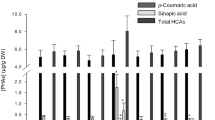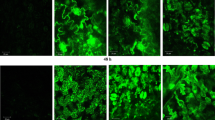Abstract
2,4-Dihydroxy-7-methoxy-1,4-benzoxazin-3-one (DIMBOA), a hydroxamic acid involved in the resistance of cereals to aphids, was administered to adult individuals of the aphid Sitobion avenae in artificial diets. Effects on the cellular metabolism were inferred from the evaluation of several organelle marker enzymes. Catalase from peroxisomes and cytochrome c oxidase from mitochondria increased their activities about twofold when aphids were fed with 2 mM DIMBOA. The role of these enzymes in the metabolizing of xenobiotics by aphids is discussed. Biochemical and cytochemical evidences for the presence of peroxisomes in aphids are reported here for the first time.
Similar content being viewed by others
REFERENCES
ArgandoÑa, V. H., Luza, J. G., Niemeyer, H. M., and Corcuera, L. J. 1980. Role of hydroxamic acids in the resistance of cereals to aphids. Phytochemistry 19:1665-1668.
ArgandoÑa, V. H., PeÑa, G. F., Niemeyer, H. M., and Corcuera, L. J. 1982. Effect of cysteine on stability and toxicity to aphids of a cycle hydroxamic acid from gramineae. Phytochemistry 21:1573-1574.
ArgandoÑa, V. H., Corcuera, L. J., Niemeyer, H. M., and Campbell, B. C. 1983. Toxicity and feeding deterrency of hydroxamic acids from Gramineae in synthetic diets against the greenbug, Schizaphis graminum. Entomol. Exp. Appl. 34:134-138.
ArgandoÑa, V. H., ZÚÑiga, G. E., and Corcuera, L. J. 1987. Distribution of gramine and hydroxamic acids in barley and wheat leaves. Phytochemistry 26:1917-1918.
Auclair, J. L. 1965. Feeding and nutrition of the pea aphid, Acyrthosiphon pisum (Homoptera: Aphidae), on chemically defined diets of various pH and nutrient levels. Ann. Entomol. Soc. Am. 58:855-875.
Azeredo-Espin, A. M. L., Schroder, R. F. W., Huettel, M. D., and Sheppard, W. S. 1991. Mitochondrial DNA variation in geographic populations of Colorado potato beetle, Leptinotarsa decemlineata (Coleoptera: Chrysomelidae). Experientia 47:483-485.
Bohidar, K., Wratten, S. D., and Niemeyer, H. M. 1986. Effect of hydroxamic acids on the resistance of wheat to the aphids Sitobion avenae. Ann. Appl. Biol. 109:193-198.
Bowers, W. E., and de Duve, C. 1967. Lysosomes in lymphoid tissue. II. Intracellular distribution of acid hydrolases. J. Cell Biol. 32:339-348.
Cuevas, L., and Niemeyer, H. M. 1993. Effect of hydroxamic acids from cereals on aphid cholinesterases. Phytochemistry 34:983-985.
De Bruijn, M. H. J. 1983. Drosophila melanogaster mitochondrial DNA, a novel organization and genetic code. Nature 304:234-241.
De Duve, C., and Baudhuin, P. 1966. Peroxisomes (microbodies and related particles). Physiol. Rev. 46:323-357.
Figueroa, C., Kawada, M. E., Munizaga, A., GonzÁlez, S., Barros, C., Koenig, C., Santos, M. J. 1997. Subcellular localization of catalase in sea urchin (Tetrapigus niger) gametes: Implications for peroxisome biogenesis. Comp. Biochem. Physiol. B 118:757-763.
Figueroa, C. C., Simon, J. C., Le Gallic, J. F., and Niemeyer, H. M. 1999. Molecular markers to differentiate two morphologically close species of the genus Sitobion (Homoptera: Aphidoidea). Entomol. Exp. Appl. In press.
Givovich, A., and Niemeyer, H. M. 1994. Effect of hydroxamic acids on feeding behaviour and performance of cereal aphids (Hemiptera: Aphididae) on wheat. Eur. J. Entomol. 91:371-374.
Givovich, A., and Niemeyer, H. M. 1995. Comparison of the effect of hydroxamic acids from wheat on five species of cereal aphids. Entomol. Exp. Appl. 74:115-119.
Givovich, A., Morse, S., Cerda, H., Niemeyer, H. M., Wratten, S. D., and Edwards, P. J. 1992. Hydroxamic acid glucosides in honeydew of aphids feeding on wheat. J. Chem. Ecol. 18:841-846.
Hall, H. G., and Smith, D. R. 1991. Distinguishing African and European honeybee matrilines amplified mitochondrial DNA. Proc. Nat. Acad. Sci. U.S.A. 88:4548-4552.
JimÉnez, D. R., and Gilliam, M. 1996. Peroxisomal enzymes in the honey bee midgut. Arch. Insect Biochem. Physiol. 31:87-103.
Lazarow, P. B., and Fujiki, Y. 1985. Biogenesis of peroxisomes. Annu. Rev. Cell Biol. 1:489-530.
Leszczynski, B., Wright, L. C., and Bakowski, T. 1989. Effect of secondary plant substances on winter wheat resistance to grain aphid. Entomol. Exp. Appl. 52:135-139.
Leszczynski, B., Matok, M., and Dixon, A. F. G. 1992. Resistance of cereals to aphids: The interaction between hydroxamic acids and UDP-glucose transferase in the aphid. Sitobion avenae (Homoptera: Aphididae). J. Chem. Ecol. 18:1189-1200.
Leszczynski, B., Matok, M., and Dixon, A. F. G. 1994. Detoxification of cereal plant allelochemicals by aphids: activity and molecular weights of glutathione-S-transferase in three species of cereal aphids. J. Chem. Ecol. 20:387-394.
Lowry, O. H., Rosebrough, N. J., Farr, A. L., and Randall, R. J. 1951. Protein measurement with the Folin phenol reagent. J. Biol. Chem. 193:265.
Mannaerts, G. P., and Van Veldhoven, P. P. 1993. Metabolic pathways in mammalian peroxisomes. Biochimie 75:147-158.
MartÍnez-GonzÁlez, J., and Hegardt, F. G. 1994. Cytochrome c oxidase subunit 1 from the cockroach Blatella germanica: Cloning, developmental pattern and tissue expression. Insect Biochem. Mol. Biol. 24:619-626.
Mullin, C. A., and Scott, J. G. 1992. Molecular Mechanisms of Insecticide Resistance. Diversity Among Insects. ACS Symposium Series. American Chemical Society, Washington, D.C.
Nicol, D., Copaja, S. V., Wratten, S. D., and Niemeyer, H. M. 1992. A screen of worldwide wheat cultivars for hydroxamic acid levels and aphid antixenosis. Ann. Appl. Biol. 121:11-18.
Niemeyer, H. M. 1988. Hydroxamic acids (4-hydroxy-1,4-benzoxazin-3-ones), defence chemicals in the Gramineae. Phytochemistry 27:3349-3358.
Niemeyer, H. M., Pesel, E., Franke, S., and Francke, W. 1989. Ingestion of the benzoxazinone DIMBOA from wheat plants by aphids. Phytochemistry 28:2307-2310.
Niemeyer, H. M., Copaja, S. V., and BarrÍa, B. N. 1992. The Triticeae as sources of hydroxamic acids, secondary metabolites in wheat conferring resistance against aphids. Hereditas 116:295-299.
Niemeyer, H. M., Givovich, A., and Copaja, S. V. 1993. Hydroxamic acids: chemical defences in wheat against aphids, pp. 39-43, in S. A. Corey, D. J. Dall, and W. M. Milne (eds.). Pest Control and Sustainable Agriculture, CSIRO, Australia.
Roels, F., and Goldfischer, S. 1979. Cytochemistry of human catalase: the demonstration of hepatic and renal peroxisomes by a high temperature procedure. J. Histochem. Cytochem. 27:1471-1477.
Santos, M. J., Imanaka, T., Shio, H., Small, G. M., and Lazarow, P. B. 1988. Peroxisomal membrane ghosts in Zellweger syndrome—aberrant organelle assembly. Science 239:1536-1538.
Santos, M. J., Kawada, M. E., Espeel, M., Figueroa, C., Alvarez, A., Hidalgo, U., and Metz, C. 1994. Characterization of human peroxisomal membrane proteins. J. Biol. Chem. 269:24890-24896.
Sunnucks, P., and Hales, D. F. 1996. Numerous transposed sequences of mitochondrial cyochrome oxidase I–II in aphids of the genus Sitobion (Hemiptera: Aphididae). Mol. Biol. Evol. 13:510-524.
Thackray, D. J., Wratten, S. D., Edwards, P. J., and Niemeyer, H. M. 1990. Resistance to the aphids Sitobion avenae and Rhopalosiphum padi in Gramineae in relation to hydroxamic acid levels. Ann. Appl. Biol. 116:573-582.
Van Kuilenburg, A. B. P., Dekker, H. L., Van den Boget, C., Nieboer, P., Van Gelder, B. P., and Muijsers, A. O. 1991. Isoforms of human cytochrome c oxidase. Subunit composition and steady-state kinetic properties. Eur. J. Biochem. 109:615-622.
ZuÑiga, G. E., and Corcuera, L. J. 1986. Effect of gramine in the resistance of barley seedlings to the aphid Rhopalosiphum padi. Entomol. Exp. Appl. 40:259-262.
Author information
Authors and Affiliations
Rights and permissions
About this article
Cite this article
Figueroa, C.C., Koenig, C., Araya, C. et al. Effect of Dimboa, a Hydroxamic Acid from Cereals, on Peroxisomal and Mitochondrial Enzymes from Aphids: Evidence for the Presence of Peroxisomes in Aphids. J Chem Ecol 25, 2465–2475 (1999). https://doi.org/10.1023/A:1020870023736
Issue Date:
DOI: https://doi.org/10.1023/A:1020870023736




